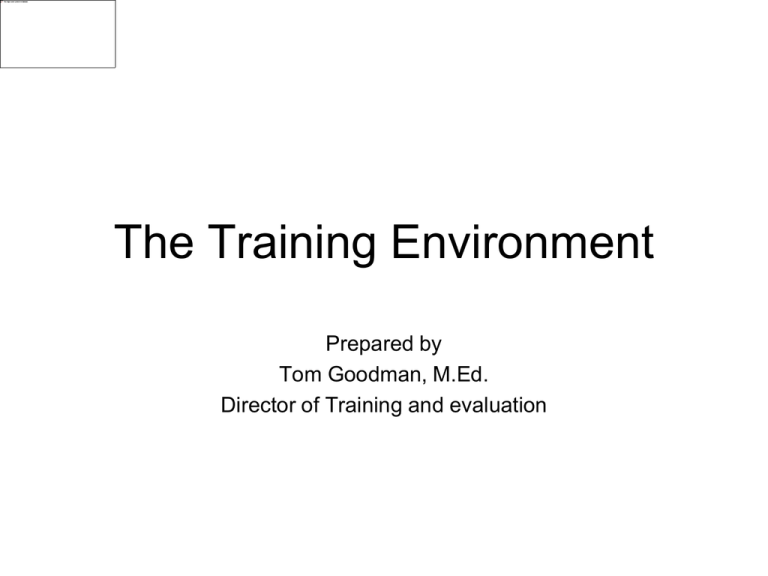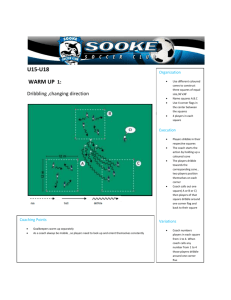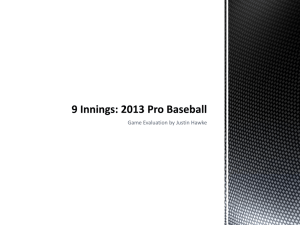The Training Environment
advertisement

The Training Environment Prepared by Tom Goodman, M.Ed. Director of Training and evaluation Cycle of Development The creation of a quality training environment to foster quality player development is determined by a Cycle of Events and Processes. In our sport we call this the Cycle of Development: Game Analysis Training Game Analysis Training Game Cycle of Development Game (match) Evaluate performance of the players Identify problems Analysis Review problems Determine priorities Training Develop/create the training session Correct problems Principles of Coaching Organization progression equipment time field space players Observation watch your team in games in training sessions watch your opponents Demonstration… paint the picture Information… feedback to players Principles of the Game Principles of Attack penetration support width/length mobility improvisation Principles of Defense pressure cover balance compactness counter-attack Training Session Design Considerations Demands of the Game The moving ball Body and ball control Decision making Opposition Stresses of the game Elements of the Game Ball Teammates Field of Play Direction of play Objectives…goals/targets Opponents Decision making Training Session Design Considerations Playing Area Size Shape Number of players Topic/theme Direction Natural markings Components of the Game Technical Tactical Physical Psychological Training Session Design Considerations Economical Training Activities that are like the game Activities that Incorporate multiple components Activities that are competitive Specificity of Training (SAID) S = Specific A = Adaptations I = Imposed D = Demands Training Variables Goals Number of goals Size of goals Shape of goals Field Size of field Shape of field Divisions of field Balls Number of balls Placement of balls Service of balls Players Number of players Neutral players Numbers up/down Age/ability of players Training Variables Rules Restrictions Incentives Offsides Point system Miscellaneous Outdoors vs indoors Field surface Equipment Time/duration Lesson Plan Organization Organization…simple to complex 1. Warm-up Activity Technical repetition…technical speed No pressure or light pressure from opponents Pressure from ball and imposed demands 2. Small Sided Game Activity Introduce pressure from opponent(s) Non-directional or directional Lesson Plan Organization Organization…simple to complex 3. Expanded Small Sided Game Activity Increase number of players Directional…looks like the game 4. Scrimmage (game) Play soccer The game with the rules (offsides, etc.) Lesson Plan Activities “Make sure activities are realistic to the game!” Name each activity Free dribble 4v4 to 4 goals Etc. Describe each activity Objectives Rules Restrictions and/or incentives Point system Lesson Plan Activities “Make sure activities are realistic to the game!” Diagram each activity Shape of field Dimensions of field Number & formation of players (X’s, O’s and N’s for neutral players) Include movement symbols straight line = pass dotted line = run scribbled line = dribble Use area of the field applicable to the topic Goal area for goalkeeping Attacking 3rd for finishing Etc. Lesson Plan Content Does it look like soccer? Does the activity/practice bring out the elements of the game? Will the players understand where the practice fits into the game? Are the objectives for the players realistic? Are instructions clear and concise? Lesson Plan Delivery Player Considerations Need time for uninterrupted play need to concentrate need to hear the game need to establish a rhythm of play need to have a chance to solve problems on their own Lesson Plan Delivery Coach Considerations… use the Coach’s Toolkit • • • • • Allow the conditions of the game to coach the theme Coach at natural stoppages Coach in the flow of the game Coach individual players as game continues Coach using the freeze method…freeze, correct, rehearse, restart Things to Avoid • Excessive coaching…over-coaching • Incorrect or inappropriate activities • Activities that are unrealistic • Training sessions that don’t flow and are frustrating Final thoughts • Find ways to make the training environment competitive • Give rest periods for rest and water (appropriate work to rest ratio) • Demand technical precision • Hold players accountable for their decisions on the field • Keep the session flowing • Make it FUN…It is a game after all! Sample lesson plan Lesson Plan Topic: Dribbling for Penetration Organization Age group: U14 Diagram Coaching Points Free Dribble: players dribble freely throughout the grid (20 x 25 yds). Players work on moves. Select a few players to add passive pressure by jogging at the dirbblers. Head up; bent knees; ball close to body; change speed; change direction 1v1 competition: set up many 1v1 fields (10 x 15 yds.), side by side. Assign 6 players to each field; 3 players at each goal. 2 play while 4 rest for 30 second bouts. Body feint or dribbling movement to “throw” the defender one way; perform the feint early enough to beat the opponent; change of direction; change of speed; explode past the defender 3v3 to four goals: Each team of 3 defends 2 goals and attacks the other 2 goals. Field wider than longer (25 x 30 yds.) 2 points are awarded when a player dribbles thru their opponent’s goals. 1 point is awarded for a pass thru a goal. 6v6 scrimmage: play a 6v6 match. Field size: 70 x 50 yds. Reinforce the points listed in the activities listed above. Use teammates as decoys…fake the pass to teammates and dribble by opponents. Reinforce the points listed in the activities above. Correct team attacking shape to provide options to dribble for penetration. Credits • United States Soccer Federation, National C License Curriculum Manual, 2003 • Goodman, Tom, M.Ed., Soccer Coaching Made Easy…A Coach’s Guide to Player Development, Reedswain Publishing, 2005 Thank you for your attention!







